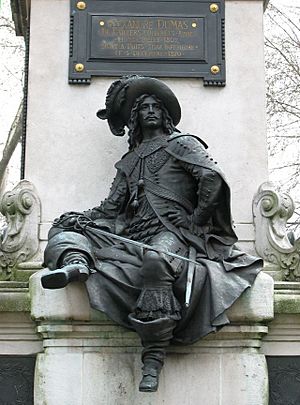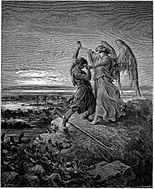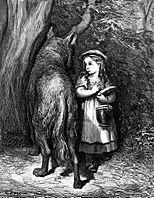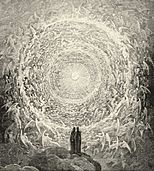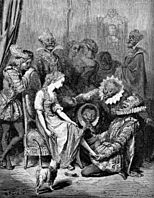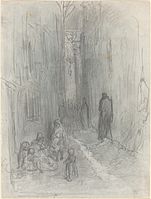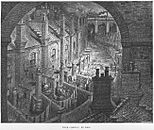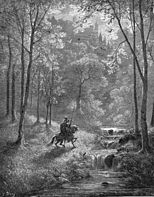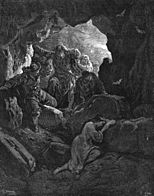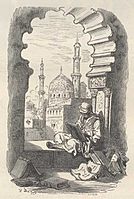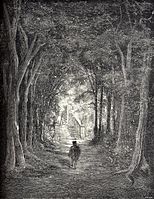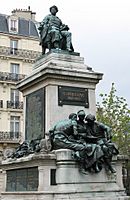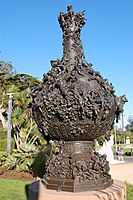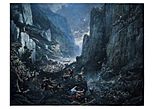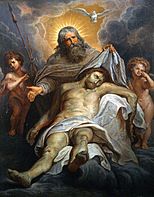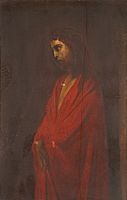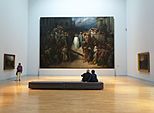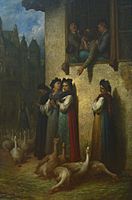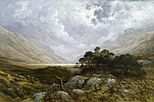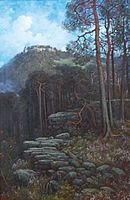Gustave Doré facts for kids
Quick facts for kids
Paul Gustave Doré
|
|
|---|---|
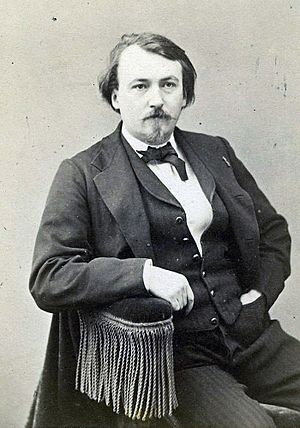
Photograph by Nadar, 1867
|
|
| Born | 6 January 1832 Strasbourg, France
|
| Died | 23 January 1883 (aged 51) Paris, France
|
| Known for | Painting, etching, illustrations |
Paul Gustave Louis Christophe Doré (born January 6, 1832 – died January 23, 1883) was a talented French artist. He was a printmaker, illustrator, painter, comics artist, caricaturist, and sculptor. He is most famous for his many wood-engravings, especially those he made for classic books.
Gustave Doré created an amazing 241 illustrations for the Bible. These pictures became very popular around the world. He is known as one of the best artists in this type of printmaking. Even though he designed the images, about 40 people helped him carve his drawings onto wooden blocks for printing. In total, he made around 10,000 illustrations. These drawings were printed in huge numbers and reached many people in different countries at the same time.
Contents
Gustave Doré's Early Life and Career
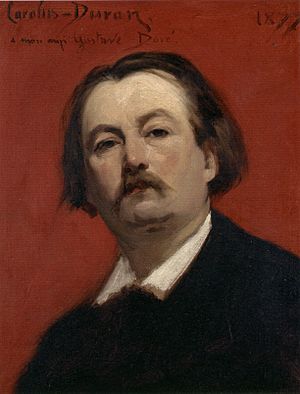
Gustave Doré was born in Strasbourg, France, on January 6, 1832. He was a child genius. By the age of five, he was already creating drawings that looked like they were made by a much older artist. When he was twelve, he started carving in stone.
At just 15 years old, Doré began his professional career. He worked as a caricaturist, drawing funny pictures for a French newspaper called Le journal pour rire. He was inspired by the illustrations of J. J. Grandville. At this time, he mainly used wood-engraving for his art. In the late 1840s and early 1850s, he also created several text comics, which are like early graphic novels. Some of these were Les Travaux d'Hercule (1847) and L'Histoire de la Sainte Russie (1854).
Soon, Doré started getting requests to illustrate famous books. He drew scenes for works by writers like Miguel de Cervantes, François Rabelais, Honoré de Balzac, John Milton, and Dante Alighieri. In 1854, he illustrated "Gargantua et Pantagruel."
In 1853, Doré was asked to illustrate the writings of Lord Byron. After this, he worked for British publishers, including creating illustrations for a new Bible.
Famous Illustrations and Success
In the 1860s, Gustave Doré illustrated a French version of Miguel de Cervantes's famous book, Don Quixote. His pictures of the knight Don Quixote and his helper, Sancho Panza, became so well-known that they shaped how people imagined these characters. Doré also illustrated a large edition of Edgar Allan Poe's poem "The Raven." He earned a lot of money for this project.
The French government recognized his talent and made him a Chevalier de la Légion d'honneur in 1861. This is a very important award in France.
Doré's illustrations for the Bible (published in 1866) were a huge success. In 1867, he had a big art show in London. This show led to the opening of the Doré Gallery in London, where his art was displayed.
In 1869, Blanchard Jerrold, a writer, suggested that they create a detailed book about London. Doré agreed to a five-year contract with a publisher, which meant he would stay in London for three months each year. He was paid a very large sum of money for this project. While Doré was known for his paintings, his woodcuts and engravings, like those he made for Jerrold, truly showed his unique artistic vision.
The finished book, London: A Pilgrimage, was published in 1872. It had 180 wood engravings. The book was popular and sold well. However, some British art critics didn't like it because it showed a lot of poverty in London. They said Doré was "inventing rather than copying" the scenes. But the famous painter Vincent van Gogh was impressed by it. He even painted his own version of Doré's Prisoners' Round in 1890. The book was a financial success, and Doré received more requests from other British publishers.
Later in his career, Doré illustrated new editions of many classic books. These included Rime of the Ancient Mariner by Samuel Taylor Coleridge, Paradise Lost by John Milton, Idylls of the King by Alfred, Lord Tennyson, and The Divine Comedy. His artwork also appeared in the weekly newspaper The Illustrated London News.
His Final Years
Gustave Doré never married. After his father passed away in 1849, he continued to live with his mother. He kept illustrating books until he died in Paris on January 23, 1883. He had a short illness before his death. At the time he passed away, he was working on illustrations for a new edition of Shakespeare's plays.
Images for kids
Gallery
- Illustrations
-
The Empyrean, Dante's The Divine Comedy
-
Doré illustrated several fairy tales: Cendrillon (or Cinderella).
-
Drawing, A Backstreet in London, 1868, National Gallery of Art
-
Edyrn with His Lady and Dwarf Journey to Arthur's Court, in Idylls of the King by Alfred, Lord Tennyson, illustrated by Gustave Doré
- Sculptures
-
Le Poème de la Vigne or The Vintage Vase, version in San Francisco
-
Cupid and Time, modello in terracotta
-
Maenads in a Wood, 1879, plaster modello, Museum of Fine Arts, Boston
- Paintings
-
La Sainte Trinité, Glynn Vivian Art Gallery
-
Ecce Homo, Glynn Vivian Art Gallery
-
La folie, Glynn Vivian Art Gallery
-
Loch Lomond, 1875
-
Landscape in Scotland, ca. 1875, Toledo Museum of Art
-
Landscape in Scotland, ca. 1878, Walters Art Museum
See also
 In Spanish: Gustave Doré para niños
In Spanish: Gustave Doré para niños


